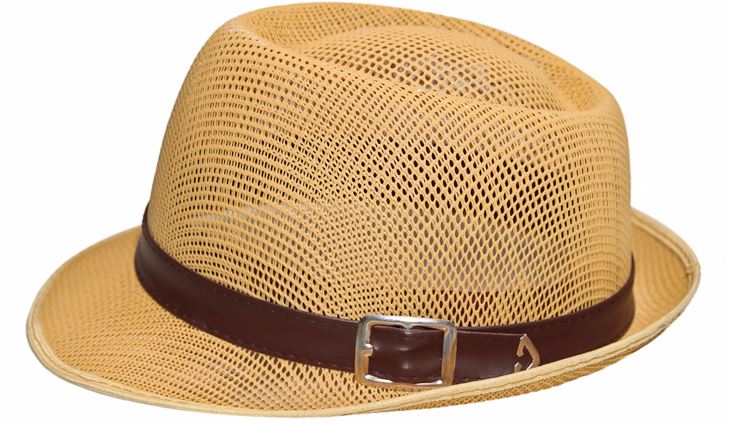Many women and men reinvent vintage hat styles to create new variations of fashion accessories. Panama hats, fedoras, and other similar designs that have been popular for decades are making a huge comeback. The Pork Pie hat is no different.
Many people, however, are foreign to the Pork Pie hat design. These hats have continued to thrive since their inception almost 200 years ago, despite not having the mainstream appeal of the fedora. As a result, many contemporary fashion enthusiasts are curious about this enigmatic yet popular fashion accessory.
In today’s guide, we’ll look at the Pork Pie hat. So, let’s get this party started!
What Is a Pork Pie Hat?
Though the Pork Pie hat (also called “English Pastry” or “porkpie” hat) encompasses a wide range of specific materials and styles, they all adhere to the same basic design. The brim of the Pork Pie hat is usually circular or elliptical and upturned at the edges. Its brim is always narrow, and the crown is either slightly round or flat on top.
Indentations all over the top edge of the hat are common in most variations. Pork pie hats, like fedoras, typically have dark-colored or black ribbons that provide visual separation between the crown and the brim.
So, what exactly is a Pork Pie hat? Surprisingly, the name is derived from the small groove around the hat’s top. This feature is commonly known as a “telescoped crown,” creating a top-down image resembling the popular meat pies of England; as a result, it was dubbed the Pork Pie hat!
The first Pork Pie hats appeared in the early nineteenth century and were particularly popular among upper and middle-class women in the United States and England. These hats frequently featured period-appropriate small flowers and flourishes. By the late nineteenth and early twentieth centuries, they had modified the hat men wore while going in town or working.
View this post on Instagram
Buster Keaton popularized a version of the classic Pork Pie hat for his comedic movies during the Silent Film era. It became an important part of his signature style and, as a result, a popular preference among American men.
Pork Pie hats were also widely available to people of all socioeconomic backgrounds. They could be made from inexpensive materials (such as cotton and straw) or more expensive materials (like satin and felt). As a result, the Pork Pie hat aided in the democratization of fashion, particularly in parts of Europe and the United States.
By the mid-twentieth century, demographics in the United States were changing dramatically, as were music, fashion, and culture. Many African American and Latin musicians wore the Pork Pie hat as part of their signature style. This assisted in popularizing the style even more, with people all over the Americas wearing the Pork Pie hat and associating it with American jazz.
The Pork Pie hat is still popular among people of all ages, from Gen Z to Baby Boomers. It simply has a timeless appeal (with roots in various locations and eras), making it appealing to people of all ages. The Pork Pie hat gained popularity after being worn by Walter White, the central protagonist in the popular television series Breaking Bad.
How to Wear a Pork Pie Hat
While the Pork Pie hat’s basic design has remained relatively unchanged since its inception in the nineteenth century, how it is worn has evolved. Even today, there are numerous ways to wear the Pork Pie hat, depending on various factors ranging from your style to the surrounding environment.
The way folks wear Pork Pie hats now is heavily influenced by jazz musicians from the 1950s and 1960s. While today’s fashionistas enjoy putting their spin on classic looks, the “correct” way of wearing Pork Pie hats has stayed the same (more or less) for almost half a century. So, let’s go over how to wear this hat for both men and women.
Men
Men can wear a Pork Pie hat in three ways: inclined, flat, or declined at an angle. The “flat” look is popular because it’s the easiest to maintain.
Put on the hat, ensure it fits comfortably, and place the brim’s bottom perpendicular to the ground. This is the type of style you might have observed Walter White employ in Breaking Bad.
The “inclined” style, on the other hand, is a more casual style derived from Jazz musicians of the past. This lets you keep the hat’s front upward, giving you more visibility. As a result, this style is fashionable, popular, and practical, making it one of the best options for most Pork Pie hat owners.
The “declined” style has a much more distinct appearance. You bring the brim edge downward while shifting the hat’s front 45 degrees to one side.
This style is also trendy among many Jazz musicians (both new and old), though it is not as widely used in everyday situations. It’s also worth noting that it’s unusual to see a Pork Pie hat decline with no rotation to one side or the other.
Women
Women, thankfully, wear Pork Pie hats in the same way that men do. Women, however, prefer the declined and flat looks.
The inclined look is far more common, as it is both comfortable and casual, especially for those with longer hair (learn these amazing ways to volumize your hair!). This allows you to wear a Pork Pie hat with your hair down or with a bun.
Fedora Hats vs. Pork Pie Hats
View this post on Instagram
Many people confuse the Pork Pie hat and the fedora hat because they both became extremely popular around the same time. Furthermore, both hats have indented crowns and traditional brims. There are, however, some key distinctions.
Fedora hats have much more brim versatility and can have upturned, flat, downturned, or mixed-style brims of varying lengths. On the other hand, Pork Pie hats always have short brims and are almost always upturned. Furthermore, how a fedora’s crown is creased differs from that of a Pork Pie.
A Pork Pie hat has only one circular crease around the crown’s edge, which often creates a stark contrast between the hat’s vertical and horizontal areas. On the other hand, Fedoras frequently have deeper and larger indentions covering the entire top of the crown and smaller indentions on the crown’s sides (making them easier to take off and on). So, while they share some fundamental similarities, Fedora and Pork Pie hats are vastly different in style and form!


